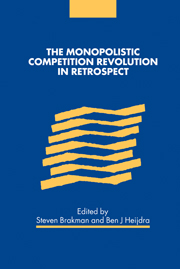1 - Introduction
Published online by Cambridge University Press: 22 September 2009
Summary
Introduction
In speaking of theories of monopolistic or imperfect competition as ‘revolutions,’ I know in advance that I shall provoke dissent. There are minds that by temperament will define away every proposed revolution. For them it is enough to point out that Keynes in 1936 had some partial anticipator in 1836. Newton is just a guy getting too much credit for the accretion of knowledge that covered centuries. A mountain is just a high hill; a hill merely a bulging plain. Such people remind me of the grammar-school teacher we all had, who would never give 100 to a paper on the ground that ‘No one is perfect.’ (Samuelson, 1967, p. 138)
Edward Hastings Chamberlin is the author of one of the most influential works of all time in economic theory – The Theory of Monopolistic Competition, which entered its eighth edition in 1962. Along with Lord Keynes's General Theory, it wrought one of the two veritable revolutions in economic theory in this century. (Dust cover text of Kuenne, 1967)
Although we stress the importance of the contribution by Avinash Dixit and Joseph Stiglitz (1977) throughout this book, the history of monopolistic competition is much longer than the past twenty-five years or so and goes back at least seventy years. The success of the Dixit–Stiglitz model of monopolistic competition might have come as a surprise to students of the history of economic thought, as it was by no means the first attempt to deal with imperfect markets or monopolistic competition.
- Type
- Chapter
- Information
- Publisher: Cambridge University PressPrint publication year: 2001



